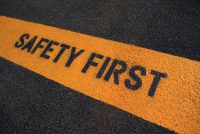Category: Special Topics in Safety Management
Safety is a process, and as such, needs to be managed. This section offers resources to create a viable safety program, sell it to senior management, train supervisors and employees in using it, and then track and report your progress. Look also for ways to advance your own skills in these areas, both for your current job, and those that follow.
Yesterday, we explained how Cintas® Corporation is making workers safer by innovating. Today, we introduce you to another VPP worksite where innovative programs are also improving safety performance. Morton Salt’s Grantsville, Utah, facility is one of the company’s four worksites to have earned VPP Star status. About 10 years back, the Grantsville plant had received […]
Read about a VPP worksite that is succeeding in making employees safer by innovating.
Yesterday, we presented answers to a number of important questions about electrical safety. Today, we review some more electrical safety FAQs. What is the best way for employees to protect against electrical hazards? Most electrical accidents result from one of three factors: Unsafe equipment or installation Unsafe environment Unsafe work practices Accidents and injuries can […]
In today’s Advisor we focus on some frequently asked questions about electrical safety, with answers provided by OSHA. What causes electrical shocks? Electricity travels in closed circuits, normally through a conductor. But sometimes a person’s body—an efficient conductor of electricity—mistakenly becomes part of the electric circuit. This can cause an electrical shock. Shocks occur when […]
As of now, no federal combustible dust rule has been released, and the CSB is taking steps to increase pressure on OSHA to issue one. In 2006, in the wake of a series of deadly major explosions and fires caused by combustible dusts, the U.S. Chemical Safety Board (CSB) issued a set of recommendations for […]
Supervisors play a key role in workplace safety. According to Oregon OSHA, supervisors have five main safety responsibilities. It identifies these in its Safety and the Supervisor training instruction guide. Provide safety training. Training must create awareness of safe behavior, teach required skills for working safely, increase knowledge by providing accurate, up-to-dater information about workplace […]
Despite the significant risk of injury or death, construction workers continue to work at heights without fall protection. A recently published study examines the reasons for this and offers solutions that could prevent an accident or save a life. The researchers/authors of Fall Protection in Residential Construction Sites, which appeared in the July issue of […]
What are the most important steps you can take to eliminate injuries and reduce the costs associated with them? Keep reading for one expert’s top 10 workplace safety tips. Kellie Crete manages safety and loss prevention for Gowrie Group (http://www.gowrie.com), a New England-based insurance provider. She says doing these 10 things can help cut losses […]
How well are you communicating safety? Benchmark these recommendations against your performance and share them with frontline supervisors. Establish a clear-cut, easy, nonthreatening method for employees to make safety suggestions or register safety concerns. This could be a dedicated Web page, a traditional suggestion box, or a mail slot in your office. Act promptly on […]
Safety professionals focus on actions like training, recordkeeping, monitoring risks, and preparing budgets. An integral part of every action is communication—what you say and how you say it. Most people believe the goal of communication is to pass on information, but in a workplace setting the purpose is more often to achieve a desired action […]


